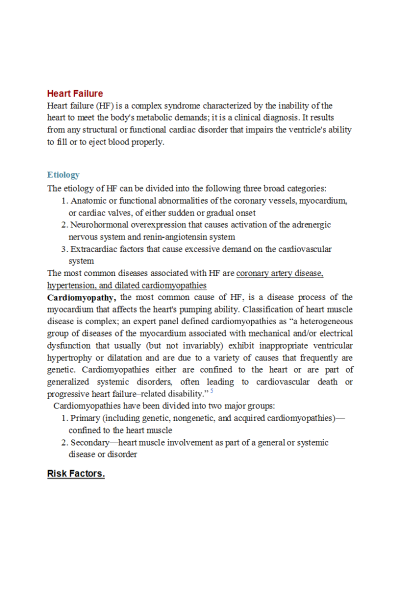NR 603 Week 3 Quiz Study Guide: 34 Pages
-
$25.00
| Institution | NR 603 Advanced Clinical Diagnosis and Practice Across the Lifespan |
| Contributor | Sharonda |
Preview of Starting Page…..
Heart Failure
Heart failure (HF) is a complex syndrome characterized by the inability of the heart to meet the body's metabolic demands; it is a clinical diagnosis. It results from any structural or functional cardiac disorder that impairs the ventricle's ability to fill or to eject blood properly.
Etiology
The etiology of HF can be divided into the following three broad categories:
1. Anatomic or functional abnormalities of the coronary vessels, myocardium, or cardiac valves, of either sudden or gradual onset
2. Neurohormonal overexpression that causes activation of the adrenergic nervous system and renin-angiotensin system
3. Extracardiac factors that cause excessive demand on the cardiovascular system
The most common diseases associated with HF are coronary artery disease, hypertension, and dilated cardiomyopathies
Preview of Last Page…..
Pathophysiology
The pathogenesis of congenital cholesteatoma is the presence of embryonic squamous epithelial cells in an ear without a history of tympanic membrane (TM) perforation or ear infection. 1 Congenital cholesteatomas arise in fetal development, but the exact cause is unclear. Primary acquired cholesteatomas are also the result of an unknown pathology but are related to retraction of the TM, usually in the pars flaccida. 1 The cause may be related to abnormal function of the eustachian tube or a chronic inflammatory cascade of events initiated by a middle ear infection. 2 The result is an accumulation of squamous epithelium, progressive erosion of the associated structures, and destruction of the delicate bones of the ossicular chain. Secondary acquired cholesteatomas develop as squamous epithelial cells enter the middle ear either after a surgical procedure (e.g., tympanoplasty) or as a direct consequence of epithelial cell shifting from the TM. 1 Advanced cholesteatomas can become secondarily infected. Typical organisms causing infected cholesteatomas include Pseudomonas aeruginosa, Proteus species, Enterobacter, Staphylococcus, Streptococcus, and anaerobes. 1 Over time, cholesteatomas can spread into intratemporal structures, causing tinnitus, otorrhea, hearing loss, twitching of the facial nerve, or paralysis of the facial nerve from infection or compression. Even with treatment, recurrence is possible.
Clinical Presentation
Congenital cholesteatomas may slowly enlarge for years and be asymptomatic. Otorrhea or hearing loss is often the presenting complaint. Acquired lesions are associated with recurrent or persistent purulent ear infections and tinnitus. Impaired hearing may be the first sign of middle ear destruction from a cholesteatoma. 4 Rarely the inflammatory process in the middle ear can result in vertigo, or the dizziness can occur from erosion of the labyrinth by the cholesteatoma.
End of 24 Pages Document Preview
| Instituition / Term | |
| Term | Fall 2020 |
| Institution | NR 603 Advanced Clinical Diagnosis and Practice Across the Lifespan |
| Contributor | Sharonda |


























